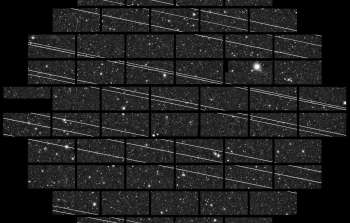sci20100 — Announcement
SATCON1 Report Delivered to NSF — Offers Roadmap to Mitigate Effects of Large Satellite Constellations on Astronomy
August 18, 2020
A report by experts representing the global astronomical community concludes that large constellations of satellites in low Earth orbit will fundamentally change ground-based OIR astronomy and identifies strategies to mitigate their impact. The report, delivered to NSF and announced at a press conference this week, is the outcome of the recent SATCON1 workshop organized by NOIRLab and AAS in late June, which brought together more than 250 scientists, engineers, satellite operators, and other stakeholders.
As described in the report, recent technology developments for astronomical research — especially wide-field imaging on large telescopes — are threatened by the launch of many thousands of low-Earth-orbiting satellites (LEOsats) by companies deploying new space-based communication technologies. Tens of thousands of satellites were already in orbit before the first Starlink launch in May 2019, but now nearly a hundred thousand are planned within a decade. While the satellites will affect much of astronomy, their impact on the Legacy Survey of Space and Time (LSST), to be carried out by the Vera C. Rubin Observatory, is a major concern.
Constellations of LEOsats are designed in part to provide communication services to underserved and remote areas. Recognizing the worthiness of that goal, astronomers have engaged satellite operators in a discussion about how to achieve that goal while avoiding undue harm to ground-based astronomical observations. The SATCON1 workshop is the latest, and most significant, step in this ongoing dialogue.
The report offers two main findings. First, LEOsats disproportionately affect science programs that require twilight observations. During twilight, the Sun is below the horizon for observers on the ground, but not for satellites hundreds of kilometers overhead, which remain illuminated. As long as satellites remain below 600 kilometers, their impact on astronomical observations is limited during the night’s darkest hours. However, satellites at higher altitudes, such as the 1200-km-high constellation planned by OneWeb, may be visible all night long during summer and for much of the night in other seasons, with serious negative consequences for many ground-based research programs.
Second, there are multiple ways to mitigate harm to astronomy from large satellite constellations:
- Launch fewer or no LEOsats. However impractical or unlikely, this is the only option identified that can achieve zero astronomical impact.
- Deploy satellites at orbital altitudes no higher than ~600 km.
- Darken satellites or use sunshades to shadow their reflective surfaces.
- Control each satellite’s orientation in space to reflect less sunlight to Earth.
- Remove or mask satellite trails and their effects when processing astronomical images.
- Make more accurate orbital information available for satellites so that observers can avoid pointing telescopes at them.
The full workshop report and individual reports from the four workshop working groups (Observations, Simulations, Mitigation, and Metrics) are available at the links below, as are additional resources. A follow-on workshop, SATCON2, which will tackle policy and regulation issues, is tentatively planned for early- to mid-2021.
Stay tuned for further details! If you are interested to get involved in future events or in the above topics on the impacts of satellite constellations, please contact Connie Walker (cwalker@noao.edu).
Links to additional resources:
Contacts
Connie Walker
Email: cwalker@noao.edu
About the Announcement
| Id: |
ID
sci20100
|
